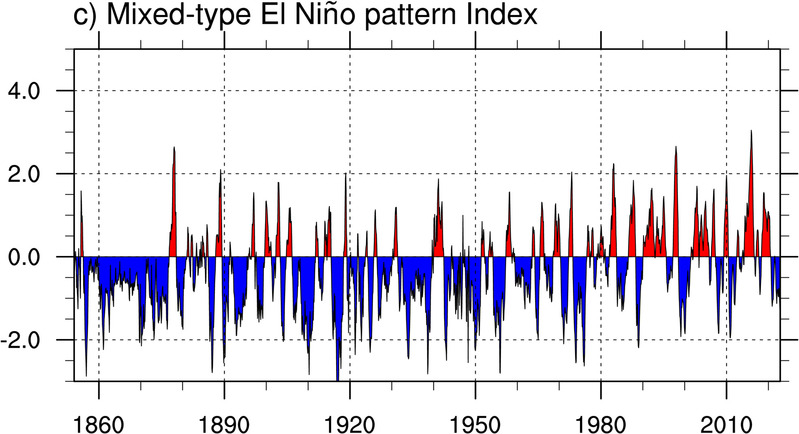Indices for different types of El Niño — updated monthly on this page for the period 1854 to present
During year-to-year El Niño events in recent decades, major sea surface warming has occurred frequently in the central Pacific. This is distinct from the eastern Pacific warming pattern during canonical El Niño events. Accordingly, the central-Pacific El Niño exerts distinct impacts on ecosystems, climate and hurricanes worldwide. The increased frequency of the new type of El Niño presents a challenge not only for the understanding of El Niño dynamics and its change but also for the prediction of El Niño and its global impacts at present and future climate.
A recent study (Sullivan et al. 2016) has proposed simple indices to represent the different types of El Niño, which can be used for understanding, prediction, and impact assessment:
Sullivan, A., J.-J. Luo*, A. C. Hirst, D. Bi, W. Cai and J. He, 2016: Robust contribution of decadal anomalies to the frequency of central-Pacific El Niño . Scientific Reports, 6, 38540; doi: 10.1038/srep38540
Indices for Eastern Pacific (EP) type, Central Pacific (CP) type, and mixed type of El Niño are calculated as in 1, 2 and 3 below:
1. EP = Niño3_normalized – 0.5 * Niño4_normalized
2. CP = Niño4_normalized – 0.5 * Niño3_normalized
3. Mixed type = EP + CP ≈ Niño3.4_normalized
Where Niño3_normalized, Niño4_normalized, and Niño3.4_normalized denote the normalized sea surface temperature (SST) anomaly in the Niño3 (5°S-5°N, 150°W-90°W), Niño4 (5°S-5°N, 160°E-150°W), and Niño3.4 (5°S-5°N, 170°W-120°W) area, respectively.
Climate impacts of the three different El Nino
ASCII data for the monthly values of the three types of El Niño from January 1854 to present:
1. Download![]() ERSST_sst.cp.index.txt here.
ERSST_sst.cp.index.txt here.
2. ![]() ERSST_sst.ep.index.txt here.
ERSST_sst.ep.index.txt here.
3. ![]() ERSST_sst.mix.index.txt here.
ERSST_sst.mix.index.txt here.


